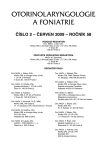Prognostic and Predictive Significance of Expression of EGFR, Her2/neu and Genetic Alterations in EGFR Signaling Pathway in Spinocellular Carcinoma of Head and Neck
Authors:
J. Neuwirthová 1; P. Smilek 1; J. Berkovcová 2; M. Hajdúch 2; J. Rottenberg 1; R. Trojanec 2; M. Dziechciarková 2; R. Kostřica 1
Authors‘ workplace:
Klinika otorinolaryngologie a chirurgie hlavy a krku LF MU a FN u sv. Anny, Brno
; přednosta prof. MUDr. R. Kostřica, CSc.
Laboratoř experimentální medicíny, Dětská a onkologická klinika LF UP a FN, Olomouc
1; přednosta doc. MUDr. M. Hajdúch, Ph. D.
2
Published in:
Otorinolaryngol Foniatr, 58, 2009, No. 2, pp. 89-96.
Category:
Original Article
Overview
We focused attention to the prognostic and predictive value of epidermal growth factor receptor (EGFR) expression HER2/neu expresion and some genetic alterations in an EGFR signal pathway, such as EGFR amplification, expression of variant form EGFRvIII, EGFR activating tyrosine kinase mutations and k-ras gene mutation. The aim of our study was to evaluate the occurrence of these biomarkers in the correlation with a therapeutic response and survival in patients with spinocellular head and neck cancers. This study suggests that EGFR expression have a clinical value mainly in early stages of the disease. We proved a presence of activating mutations in EGFR tyrosine kinase domain, k-ras mutation and correlation between EGFR gene amplification and receptor expression.
Key words:
epidermal growth factor, receptor head and neck cancers, tyosin kinase mutation, prodictive markers, oncology, chemoradiotherapy.
Sources
1. Abidoye, O. O., Cohen, E. E., Wong, S. J. et al.: A phase II study of lapatinib (GW572016) in recurrent/metastatic (R/M) squamous cell carcinoma of the head and neck (SCCHN). J. Clin. Oncol., 24, 2006, 18 (Suppl), s. 5568.
2. Ang, K. K., Berky, B. A., Tu, X. et al.: Impact of epidermal growth factor receptor expression on survival and pattern of relapse in patients with advanced head and neck carcinoma. Cancer Res., 62, 2002, 24, s. 7350-7356.
3. Arteaga, C. L.: Trastuzumab, an appropriate first-line single-agent therapy for HER2-overexpressing metastatic breast cancer. Breast Cancer Res., 5, 2003, s. 96-100.
4. Atkins, D., Reiffen, K. A., Tegtmeier, C. N. et al.: Immunohistochemical detection of EGFR in paraffin-embedded tumor tissues: Variation in staining intensity due to choice of fixative and storage time of tissue sections. Journal of Histochemistry and Cytochemistry, 52, 2004, 7, s. 893-901.
5. Aviel-Ronen, S., Blackhall, F. H., Shepherd, F. A. et al.: K-ras mutations in non-small-cell lung carcinoma: a review. Clin. Lung. Cancer, 8, 2006, 1, s. 30-38.
6. Chou, W. CH., Juany, S. F., Yeh, K. Y. et al.: Different responses to gefitinib in lung adenocarcinoma coexpressing mutant- and Wild-type epidermal growth factor receptor genes. Japanese J. Clin. Oncol., 36, 2006, 8, s. 523-526.
7. Chung, CH. H., Ely, K., McGavran, L. et al.: Increased epidermal growth factor receptor gene copy number is associated with poor prognosis in head and neck squamous cell carcinomas. J. Clin. Oncol., 24, 2006, 25, s. 4170-4176.
8. Chung, CH., Ely, K., Carter, J. et al.: High gene copy number of epidermal growth factor receptor by fluorescence in situ hybridization is frequent in head and neck squamous cell carcinomas and associates with worse recurrence-free survival. J. Clin. Oncol., ASCO Annual Meeting Proceedings, Part I., 24, 2006, 18 (Suppl), s. 5502.
9. Dziadziuszko, R., Fred, R. H., Varella-Garcia, M. et al.: Selecting lung cancer patients for treatment with epidermal growth factor receptor tyrosine kinase inhibitors by immunohistochemistry and fluorescence in situ hybridization—why, when, and how? Clinical Cancer Res., 12, 2006, s. 4409-4415.
10. Kersting, C., Packeisen, J., Leidinger, B. et al.: Pitfalls in immunohistochemical assessment of EGFR expression in soft tissue sarcomas. Journal of Clinical Pathology, 59, 2006, s. 585-590.
11. Litlekalsoy, J., Vatne, V., Hostmark, J. G. et al.: Immunohistochemical markers in urinary bladder carcinomas from paraffin-embedded archival tissue after storage for 5-70 years. BJU Int., 99, 2007, 5, s. 1013-11019.
12. Loeffler-Ragg, J., Witsch-Baumgartner, M., Tzankov, A. et al.: Low incidence of mutations in EGFR kinase domain in caucasian patients with head and neck squamous cell carcinoma. Eur J. Cancer, 42, 2006, 1, s. 109-111.
13. Rubin Grandi, J., Melhem, M. F., Holding, W. E. et al.: Levels of TGF-alpha and EGFR protein in head and neck squamous cell carcinoma and patient survival. J. Natl. Cancer Inst., 90, 1998, 11, s. 824-832.
14. Schwentner, I., Witsch-Baumgartner, M., Sprintů, B. M. et al.: Identification of the rare EGFR mutation p.G796S as somatic and germline mutation in white patients with squamous cell carcinoma of the head and neck. Head Neck, 30, 2008, 8, s. 1040-1044.
15. Sheikh, A. M., Gunduz, M., Nagatsuka, H. et al.: Expression and mutation analysis of epidermal growth factor receptor in head and neck squamous cell carcinoma. Cancer Sci, 99, 2008, 8, s. 1589-1594.
16. Temam, S., Kawaguchi, H., El-Naggar, A. K. et al.: Epidermal growth factor receptor copy number alterations correlate with poor clinical outcome in patients with head and neck squamous cancer. J. Clin. Oncol., 25, 2007, 16, s. 2164-2170.
17. Trojanec, R., Špačková, K., Cwiertka, K. et al.: Amplifikace genu Her-2/neu: molekulární, buněčné a klinické aspekty. Klin. Farmakol. Farmac., 16, 2002, s. 23-29.
18. Willmore-Payne, C., Holden, J. A., Layfield, L. J. et al.: Detection of EGFR- and HER2-activating mutations in squamous cell carcinoma involving the head and neck. Mod. Pathol., 19, 2006, 5, s. 634-640.
Labels
Audiology Paediatric ENT ENT (Otorhinolaryngology)Article was published in
Otorhinolaryngology and Phoniatrics

2009 Issue 2
Most read in this issue
- Parapharyngeal and Retropharyngeal Abscess in Children
- Foreign Bodies in ORL Area in Children
- Radiofrequency Induced Tonsil Thermotherapy in Children
- Incidence of Helicobacter Pylori in Nasal Lymphatic Tissues and its Possible Link to Adenoidal Vegetation
